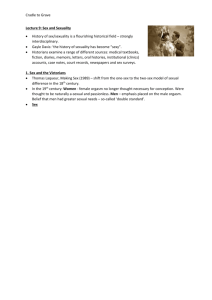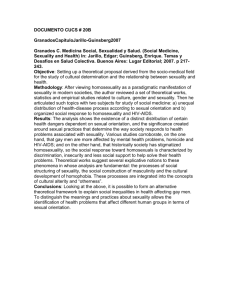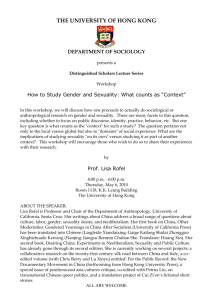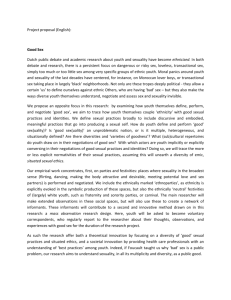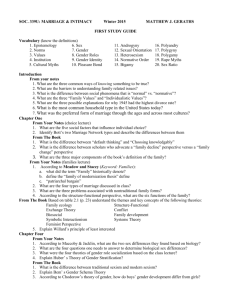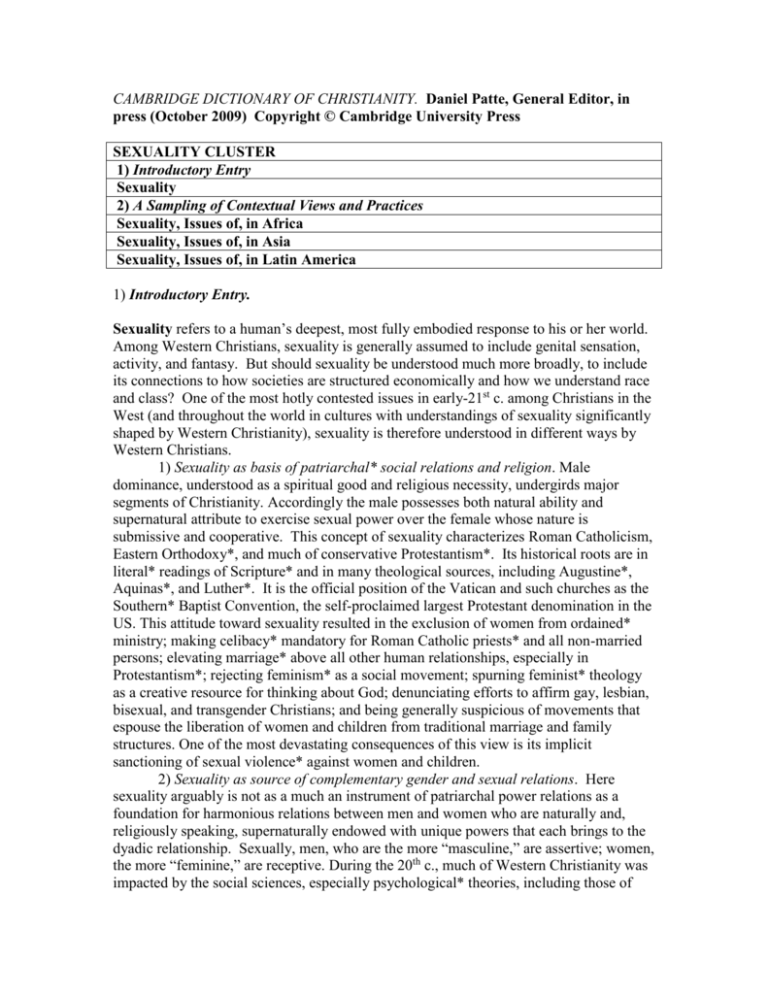
CAMBRIDGE DICTIONARY OF CHRISTIANITY. Daniel Patte, General Editor, in
press (October 2009) Copyright © Cambridge University Press
SEXUALITY CLUSTER
1) Introductory Entry
Sexuality
2) A Sampling of Contextual Views and Practices
Sexuality, Issues of, in Africa
Sexuality, Issues of, in Asia
Sexuality, Issues of, in Latin America
1) Introductory Entry.
Sexuality refers to a human’s deepest, most fully embodied response to his or her world.
Among Western Christians, sexuality is generally assumed to include genital sensation,
activity, and fantasy. But should sexuality be understood much more broadly, to include
its connections to how societies are structured economically and how we understand race
and class? One of the most hotly contested issues in early-21st c. among Christians in the
West (and throughout the world in cultures with understandings of sexuality significantly
shaped by Western Christianity), sexuality is therefore understood in different ways by
Western Christians.
1) Sexuality as basis of patriarchal* social relations and religion. Male
dominance, understood as a spiritual good and religious necessity, undergirds major
segments of Christianity. Accordingly the male possesses both natural ability and
supernatural attribute to exercise sexual power over the female whose nature is
submissive and cooperative. This concept of sexuality characterizes Roman Catholicism,
Eastern Orthodoxy*, and much of conservative Protestantism*. Its historical roots are in
literal* readings of Scripture* and in many theological sources, including Augustine*,
Aquinas*, and Luther*. It is the official position of the Vatican and such churches as the
Southern* Baptist Convention, the self-proclaimed largest Protestant denomination in the
US. This attitude toward sexuality resulted in the exclusion of women from ordained*
ministry; making celibacy* mandatory for Roman Catholic priests* and all non-married
persons; elevating marriage* above all other human relationships, especially in
Protestantism*; rejecting feminism* as a social movement; spurning feminist* theology
as a creative resource for thinking about God; denunciating efforts to affirm gay, lesbian,
bisexual, and transgender Christians; and being generally suspicious of movements that
espouse the liberation of women and children from traditional marriage and family
structures. One of the most devastating consequences of this view is its implicit
sanctioning of sexual violence* against women and children.
2) Sexuality as source of complementary gender and sexual relations. Here
sexuality arguably is not as a much an instrument of patriarchal power relations as a
foundation for harmonious relations between men and women who are naturally and,
religiously speaking, supernaturally endowed with unique powers that each brings to the
dyadic relationship. Sexually, men, who are the more “masculine,” are assertive; women,
the more “feminine,” are receptive. During the 20th c., much of Western Christianity was
impacted by the social sciences, especially psychological* theories, including those of
Sigmund Freud and of the more spiritually-inclined Carl Jung and his followers. Under
the influence of both psychology and feminism, liberal Roman Catholics and Protestants
developed (late 20th c.) this complementary understanding of sexuality. Theologically,
this position presupposes a Western version of a “yin-yang” spiritual energy in the
universe. This “masculine/feminine” sexual energy is embodied by men and women in
accordance with their given (or assigned) biological identity as male or female. This
theory has been challenged as the stability of male/female biological identity has become
less certain and assumptions about gender, as a psycho-social construct, have become
more fluid. Sometimes used by liberal, or progressive, Christians to discredit gay, lesbian,
and other sexual liberation movements, the complementarity theory has served primarily
as a way to soften, rather than seriously challenge, patriarchal social relations and
religion.
3) Sexuality as spiritual energy for shaping mutual relation in the world.
Feminist liberation theologies and some womanist* theologies have seriously challenged
both previous understandings by asserting that sexuality is a deeply embodied yearning
for right, mutual relations with the world, including those persons closest to us, but
extending to the larger realms of social justice. In this view, one’s sexual partners need
not be of “the opposite” sex. “Opposite” is itself misleading for imagining right, mutual
relations between men and women, just as “opposition” is a mistaken way to think of
how people of different races, tribes, religions, and cultures are rightly related. Feminist
and womanist theologies, later joined by queer* theologies, introduced in late-20th c.
passionate, intelligent voices to Roman Catholic, Orthodox, and Protestant Western
traditions. In the US the Unitarian* Universalist Association and the United* Church of
Christ have taken the feminist theological critique of traditional sexual understandings
most seriously in theory and practice. From this perspective, most of Christianity is held
fast and more or less static by its patriarchal moorings. As long as this prevails, Christian
discourse will not transcend its polarized understandings of human beings as either male
or female, and either heterosexual* or homosexual*, without any variation or spectrum of
identities. Thus feminist and queer theologians argue that the church will remain mired
in patriarchal power-relations and sexual injustice until it begins to catch up with the best
that science and other arenas of human culture and discovery have to offer by
acknowledging sexuality as shaping mutual relation.
For the foreseeable future, Western churches, and much of the rest of global
Christianity, are likely to be bitterly divided between those whose faith is anchored in
patriarchal or complementary understandings of sexuality and those who believe the
Spirit is leading them into understanding sexuality as a passion for mutual relation.
CARTER HEYWARD
2) A Sampling of Contextual Views and Practices.
Sexuality in Africa. Silence surrounds sexuality and all its difficulties in African
Christian communities as well as in the African society as a whole. Although sexuality is
a central and most intimate aspect of human life, probably it is the most misconstrued,
misused and violated, especially among women and children. In Africa, sexuality is
experienced and expressed through rituals (female genital mutilation; puberty rituals;
marriage), beliefs (about life under God and African cosmology), attitudes, thoughts,
behaviors, roles and relationships (in marriage*, family*, and society) but these aspects
remain largely unexplored. However, since the 1990s, in addition to the HIV & AIDS
pandemic, two other items are forcing Christians (and others) in Africa to study sexuality:
the highly controversial issue of homosexuality* and the increased awareness of genderbased violence against women and children (see sexual* violence). Most significant is
the introduction of gender and theology courses in theological education and ministerial
formation that is forcing future church leaders and theologians to explore issues related to
sexuality, among them African masculinity and sexual violence. Yet, these are strongly
resisted. How can one teach students about sex and sexuality on the “holy” grounds of
the seminary?! Yet, such teaching takes place in a growing number of seminaries.
Another sign of hope is a renewed call for African theological and religious scholars to
study African cosmology and African* religion in their own light and as framing the
understanding of sexuality in Africa. Yet, much remain to be done, because there is a
rich and wide diversity of African cultures, religions (including Christianity), and
languages in terms of which sexuality needs to be understood. NYAMBURA J. NJOROGE
Sexuality, Issues of, in Asia. Although Asia is a vast region with diverse and rich
cultures, religions, and traditions, the expression of Asian sexuality can be characterized
by three shared traits: sex is a cultural taboo; sex is usually restricted to procreation;
women’s bodies are regarded as ritually unclean and inferior. Consequently, sexual
pleasure becomes a privilege only for men.
With the importation of Christianity into Asia, accompanied by European
imperialism, Western Christian sexual conventions in which sex is only permitted in a
one to one heterosexual marriage relationship became a dominant legal practice in most
Asian societies. However, in the past few decades, the impact of the global human rights
movement and of the feminist and queer movements challenged such a narrow religious
interpretation of sexual norms.
Today issues of sexuality discussed in Asian Christian communities include 1)
whether procreation and heterosexual marriage should be the only goal of human
sexuality and 2) how the Father God who comes to symbolize male dominance
legitimizes the power of the Church to subordinate women to male authorities. Regarding
issues of sexual violence in Asian societies and also in Christian communities, there are
many pressing concerns being addressed, including: domestic violence; sexual
harassment; discrimination against people of different sexual orientations and against
those with HIV/AIDS; double standards on virginity and its impact on women’s
sexuality; forced abortion in China*; and the dowry system in India*. Furthermore, the
borderless societies promoted by the global economy continue to exploit girls and women
by selling them as “wives” or forcing them into prostitution. As many Asian feminist
theologians point out, in analyzing sexuality we cannot just focus on sex as a personal
moral issue. Rather, we must examine the unequal power structures and the social and
religious constructions of gender, sexuality, class, and race that create systems that
exploit the vulnerable, especially poor, young, and socially outcast women.
Throughout church history, the narrowly conceived authority of Scripture* and
Christian doctrines has been used as the language of Christian imperialism, exclusivism,
and domination. Bringing liberation to women and sexual minorities demands that we
construct a liberation* theology truly framed by a holistic understanding of sexuality that
reflects the justice* and love* of God among all people, because sex is a gift from God.
The criteria to measure any sexual relationship are based neither on gender nor on the
form of sexual activity; rather, these criteria are whether there is any abuse of power,
domination, and exclusion, or holistic justice and love. ROSE WU
Sexuality, Issues of, in Latin America. In order to understand the relationship between
sexuality and Christianity in Latin America, we must first start from the assumption that
sexuality is not static, defined by essential aspects or biological identity. Rather, it is a
social construct that varies according to socio-cultural and historical contexts. It consists
of the uses and practices related to human bodies and their biological sexes, as well as to
the achievement of desires and choices.
A second assumption is made in considering Latin America as a collective unit.
Despite the enormous differences among regions, whether on the Continent or in the
Caribbean, there are some shared characteristics that give a basic homogeneity to the
region: increasing poverty* and domination by external economic powers; a history of
colonization*, authoritarianism, fragile attempts at democracy, and machismo; cultural
diversity influenced by African, indigenous, and European roots; the political and
religious predominance of the Roman Catholic Church. Thus, in dealing with the
relationship between sexuality and religion in Latin America, one must take into
consideration the predominant Catholic sexual morality in the region.
In moral and sexual terms, Christian thought connected pleasure with sin*. Sex,
seen as a tool for procreation (see Pregnancy*), was relegated to the heterosexual realm;
premarital relations were prohibited. This approach, combined with the absolutization of
the Christian family model (see Family* Cluster) and female submissiveness, shaped the
sense of what sexual practices were permitted and morally acceptable. In the area of
legislation and public policies, the influence of the Catholic Church has also been
perceptible, despite the formal separation between Church and State in most countries.
For women, especially poor women, the religious regulation of sexuality has meant strict
control over their behavior and their possibilities for autonomy in this area, as well as in
the decisions over their reproductive capacity. Christian codes on virginity and the
indissolubility of marriage vows (see Marriage* Cluster), along with the concept of
women as “naturally” mothers served to maintain religious institutions’ control over
women’s bodies.
But despite the persistence of Christian sexual morality in Latin America, there is
an enormous distance between it and the real practices of the faithful, men and women
alike. To belong to a religion does not necessarily mean to obey its dicta. Moreover,
different Christian churches vary in their thinking on sexual morality. Also in the public
sphere, the dissemination of new ideas such as the inclusion of sexuality in the human*
rights sphere has brought considerable changes in political agendas in the region. Recent
years have been marked by intense feminist mobilizations, in whose number Christian
women are included, in favor of liberalizing access to abortion*. Studies in different
countries of the region indicate growing popular support, especially among the more
educated, for the idea that marriages can come to an end and new relationships can then
be formed. The idea of homosexual* unions and other ways of expressing sexuality and
affectivity is also gaining acceptance. Indices of approval for condom use and rejection of
official Catholic doctrines on the subject (see Birth*-Control) are significant, even
among Catholics. Further contributions to these divergent positions comes via the rise of
feminist* theology, with ideas that take into account the social reality of women’s lives,
especially poor women. Such formulations approach sexuality in a positive way,
affirming the religious validity of experiencing pleasure from sexuality. MARIA JOSÉ
ROSADO-NUNES

